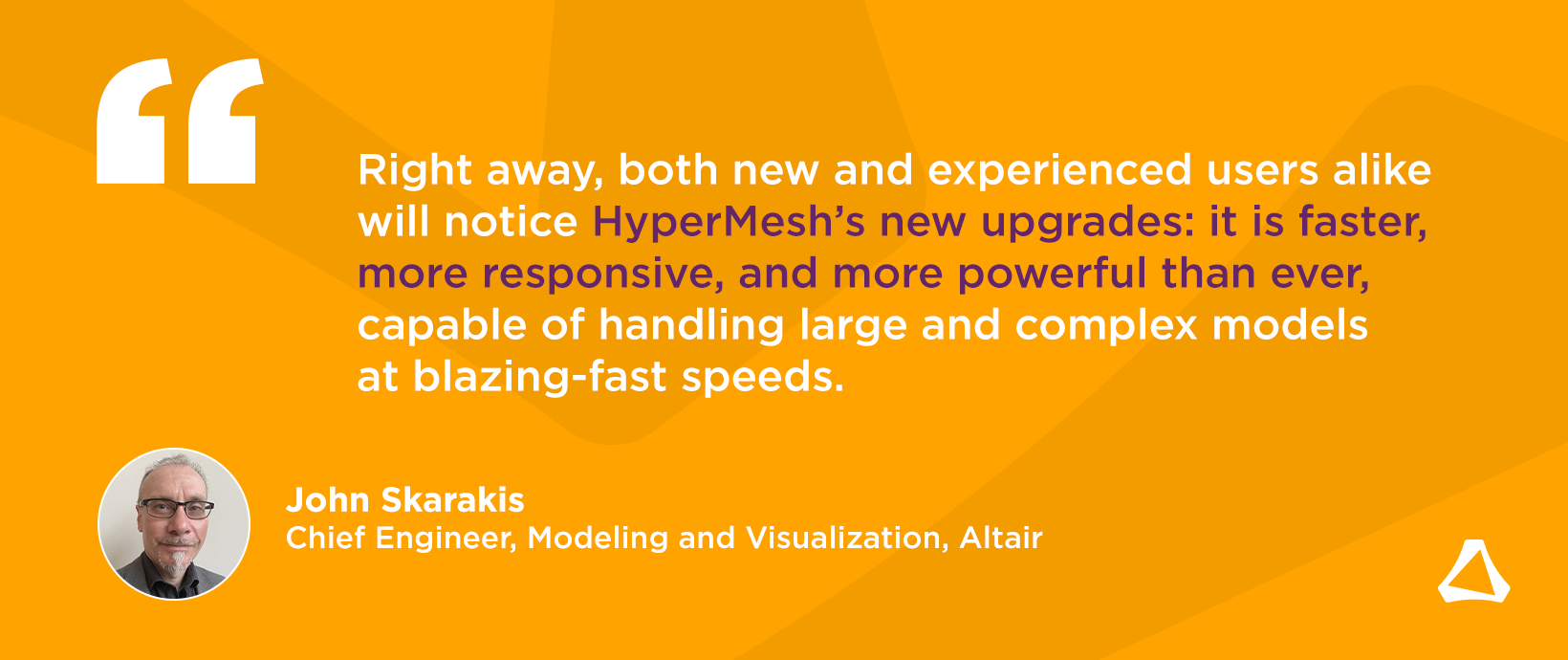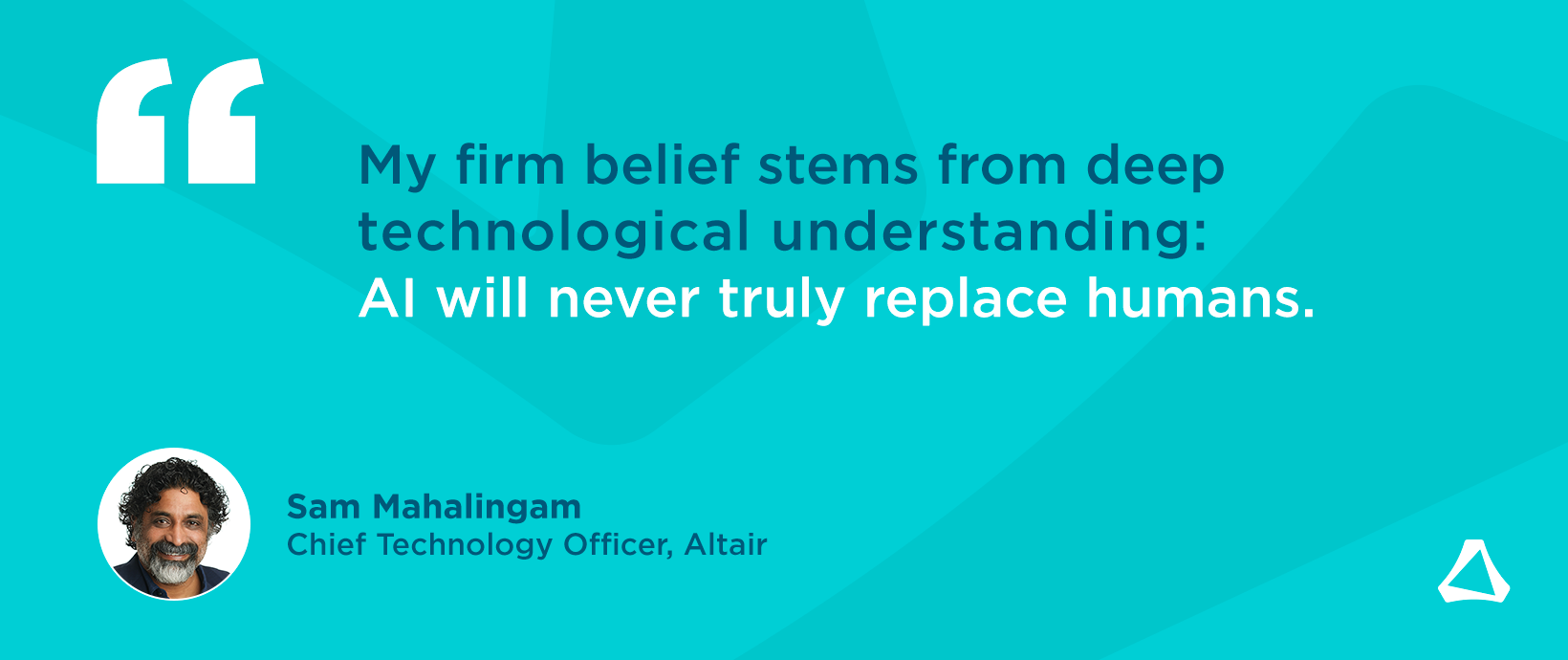Introducing the New Altair® HyperMesh® Experience

The scale of updates found in the new Altair® HyperWorks® 2023 release is massive. The capabilities our team has worked long and hard to deliver are finally here and are poised to redefine how users interact with our solutions. We believe this release – the largest update in the past decade – will help usher in a new era of our technology coming together through innovation.
In this article, I’d like to focus on one product in particular: Altair® HyperMesh®. Let’s explore how Altair HyperWorks 2023, our design and simulation platform, is augmenting and deepening one of our longtime signature solutions.
The New HyperMesh Experience: Modernization and Accessibility
Our primary objective when making upgrades within HyperMesh was simple: give users the best experience possible. We wanted HyperMesh to feel fresh, modern, and accessible for all users, no matter their level of experience or their domain/specialties. Over the years, HyperMesh has grown into a massive, powerful tool that supports a myriad of capabilities and functions. This is why it’s one of the market’s most trusted pre- and post-processing solutions and enjoys a broad, loyal worldwide following.
It’s natural that as software tools expand and deepen, they outgrow architectures and structures that once made sense when the tool was narrower. This is what HyperMesh experienced – and our team knew improving its interface and systems would give users the experiences they have always desired (and more).
The team and I strove to ensure our customers felt like using HyperMesh was a seamless experience, one that handled all their needs in a single environment, and one that catered to brand-new users and HyperMesh veterans alike. In short, the goal was to make HyperMesh as frictionless as the rest of our technology portfolio.
In the new HyperMesh experience, users no longer need to jump between environments and workflows to achieve their goals. We have also flattened HyperMesh’s learning curve for new users, cutting down the time they need to get acclimated to the tool with a more intuitive, more natural interface and experience.
Right away, both new and experienced users alike will notice HyperMesh’s new upgrades: it is faster, more responsive, and more powerful than ever, capable of handling large and complex models at blazing-fast speeds. They will also notice a tool that integrates seamlessly into Altair’s existing solutions and platforms as well as third-party solutions, building on our hallmark open and unified architecture. Let’s explore these noteworthy upgrades in more detail.
HyperMesh 2023: New Capabilities
A Modern User Experience and Interface
As mentioned, HyperMesh now features an enhanced, unified user experience that will boost productivity and empower users in new ways. It will certainly make their experience more interoperable and more cohesive across tools and applications.
This enhancement falls in line with Altair HyperWorks 2023 on a broader level, since one of the release’s main goals is to give users common environments and experiences no matter what tool they’re using.

Beyond the user interface, the team has also done great “under the hood” work to give our customers a more interconnected experience, primarily with data and other tools. Now, tools integrate seamlessly with product data management (PDM) systems and leverage shared libraries to ensure everyone is up to date. With streamlined collaboration and traceability tools, you can focus on the task at hand, confident that your team has access to the latest models and revisions. This is the essence of seamless modernization.
Logical, Intuitive Workflows
Moving onto accessibility, HyperMesh is also much more “natural” than it was. Our goal in this area was to make HyperMesh a truly democratized solution for new and existing users alike, including those who have used the tool from the very beginning. Everything – both within the interface and the back end – is much more logical than before. Ribbons, workflows, and other aspects flow from left to right, items are categorized in the order in which people build models, users can customize their experiences without needing to write scripts, and everything minimizes the need to do extended back-end modifications.
HyperMesh also features domain-driven workflows, recognizing that people work in different ways and have different needs. It also links common modules and even parts of other Altair solutions directly into the ribbons and browsers to ensure people are getting the most from this seamless experience.
To aid newcomers and users that need assistance, HyperMesh’s in-application support offers interactive tutorials and guides that simplify common tasks and provide valuable insights. An intelligent search feature bypasses the need for menu navigation, allowing users to quickly find commands and tools. Customizable keyboard shortcuts further boost efficiency, minimizing the constant shift between mouse and keyboard. Additionally, users can tailor advanced mouse controls like multi-touch gestures, trackpad support, and programmable buttons to their individual preferences, further simplifying navigation and boosting efficiency. And HyperMesh’s customizable user interface can be tailored to fit individual workflows, enhancing the user experience.
Better, Faster, More Robust Performance
But don’t think these upgrades only brought changes to HyperMesh’s look and feel. HyperMesh delivers unparalleled reliability and scalability, enabling engineering teams to handle large and complex models with ease and collaborate seamlessly across disciplines. It is incredibly fast and can handle larger, more complex models in a fraction of the time it takes traditional CAD readers to do the same. In fact, what may take a CAD reader 40 hours to do, HyperMesh can do in just 30 minutes.
In addition, HyperMesh’s modeling and visualization capabilities have taken a massive leap forward, as have its AI-augmented solutions. It leverages historical simulation data and past models, combined with geometric deep learning to generate fully animated physics predictions, enabling users to see how design changes will affect models and outcomes. It also allows users to “manufacture” this data for use in a variety of situations. Moreover, since models don’t always need to be parametrized, users can now utilize a wider variety of models and data. And because all this is taking place in the back end “behind the glass” thanks to HyperMesh’s data and tool interconnectivity, users can get results in minutes to seconds rather than hours or days. This will save users a ton of simulation/data runs, time, effort, and money.
Also new to HyperMesh is a range of solutions for concept modeling and optimization. When dealing with geometry creation, the ability to handle both simple and intricate designs is crucial. HyperMesh is adept at reverse engineering sketches and modifying existing models, which is invaluable for rapid concept development and optimization, thus streamlining the feedback loop in CAD/design. Furthermore, this approach offers users a means to explore various packaging solutions.
And lastly, another notable feature is the Design Space, which streamlines topology optimization model build and setup by providing a comprehensive set of capabilities for rapid model creation, efficient design iterations, and enhanced design optimization. The benefits from voxel design space generation, non-design space library, and collision detection, make topology optimization more accessible to a wider range of users, including those with limited CAD experience. Users can simplify the modeling process and reduce model complexity with skeleton modeling, as well as build reduced-order models by creating joints, members, and panels while editing sections in real time.
Conclusion
I’m thrilled to see what users will be able to accomplish with HyperMesh’s new features and capabilities. It has been an exciting opportunity redesign HyperMesh for the next generation of innovation, creativity, and discovery. I truly believe the team has done magnificent work and produced the market’s finest tool for all users.
Experience the next generation of HyperMesh in our upcoming webinar on November 15. To learn more about HyperMesh, visit https://altair.com/hypermesh.




